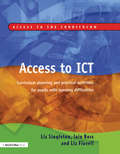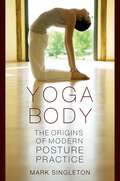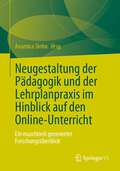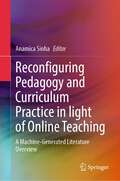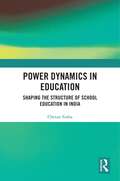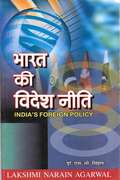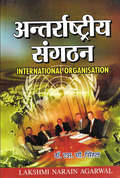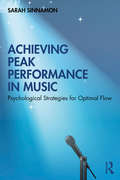- Table View
- List View
Leadership by the Number: Using the Enneagram to Strengthen Educational Leadership
by Jon E. SingletaryHarness the power of ancient Enneagram philosophy to maximize your educational leadership impact In Leadership by the Number: Using the Enneagram to Strengthen Educational Leadership, distinguished academic and leadership coach Dr. Jon Singletary walks you through how to use the ancient wisdom of the Enneagram of Personality with modern contemplative practices to transform how you lead your department, school, college, or university. You'll learn to effectively balance the conflicting demands of your role with greater patience, skill, and peace-of-mind by changing how you think, act, and feel every day. In the book, the author provides: Explanations of the benefits of self-aware leadership, including the identification of competing forces and understanding stakeholders' strengths and weaknesses Insights into the critical role of self- awareness in educational leadership Concrete strategies for strengthening university, college, unit, and departmental leadership A can't-miss resource for higher education administrators and other school leaders, Leadership by the Number also belongs in the hands of students of education and leaders-in-training who wish to maximize the impact they can have on the institutions they'll one day lead.
Access to ICT: Curriculum Planning and Practical Activities for Pupils with Learning Difficulties
by Liz Singleton Iain Ross Liz FlavellFirst Published in 2005. Routledge is an imprint of Taylor & Francis, an informa company.
Access to ICT: Curriculum Planning and Practical Activities for Pupils with Learning Difficulties
by Liz Singleton Iain Ross Liz FlavellFirst Published in 2005. Routledge is an imprint of Taylor & Francis, an informa company.
All Aboard, Easy Start Pattern and Rhyme: A Bat in a Hat
by Marie SingletonA simple, early-rhyming book using the word bat, hat, mat and cat.All Aboard teaches the strategies children need to become successful readers. It offers carefully-structured materials to develop sight vocabulary, phonological awareness and information retrieval through three specially-designed strands for Infants. It then develops the higher order reading and writing skills necessary for genuine literacy at Junior level.
All Aboard, Easy Start Pattern and Rhyme: A Bat in a Hat (PDF)
by Marie SingletonA simple, early-rhyming book using the word bat, hat, mat and cat.All Aboard teaches the strategies children need to become successful readers. It offers carefully-structured materials to develop sight vocabulary, phonological awareness and information retrieval through three specially-designed strands for Infants. It then develops the higher order reading and writing skills necessary for genuine literacy at Junior level.
All Aboard, Easy Start Pattern and Rhyme: A Bat in a Hat
by Marie SingletonA simple, early-rhyming book using the word bat, hat, mat and cat.All Aboard teaches the strategies children need to become successful readers. It offers carefully-structured materials to develop sight vocabulary, phonological awareness and information retrieval through three specially-designed strands for Infants. It then develops the higher order reading and writing skills necessary for genuine literacy at Junior level.
Yoga Body: The Origins of Modern Posture Practice
by Mark SingletonYoga is so prevalent in the modern world--practiced by pop stars, taught in schools, and offered in yoga centers, health clubs, and even shopping malls--that we take its presence, and its meaning, for granted. But how did the current yoga boom happen? And is it really rooted in ancient Indian practices, as many of its adherents claim? In this groundbreaking book, Mark Singleton calls into question many commonly held beliefs about the nature and origins of postural yoga (asana) and suggests a radically new way of understanding the meaning of yoga as it is practiced by millions of people across the world today. Singleton shows that, contrary to popular belief, there is no evidence in the Indian tradition for the kind of health and fitness-oriented asana practice that dominates the global yoga scene of the twenty-first century. Singleton's surprising--and surely controversial--thesis is that yoga as it is popularly practiced today owes a greater debt to modern Indian nationalism and, even more surprisingly, to the spiritual aspirations of European bodybuilding and early 20th-century women's gymnastic movements of Europe and America, than it does to any ancient Indian yoga tradition. This discovery enables Singleton to explain, as no one has done before, how the most prevalent forms of postural yoga, like Ashtanga, Bikram and "Hatha" yoga, came to be the hugely popular phenomena they are today. Drawing on a wealth of rare documents from archives in India, the UK and the USA, as well as interviews with the few remaining, now very elderly figures in the 1930s Mysore asana revival, Yoga Body turns the conventional wisdom about yoga on its head.
Yoga Body: The Origins of Modern Posture Practice
by Mark SingletonYoga is so prevalent in the modern world--practiced by pop stars, taught in schools, and offered in yoga centers, health clubs, and even shopping malls--that we take its presence, and its meaning, for granted. But how did the current yoga boom happen? And is it really rooted in ancient Indian practices, as many of its adherents claim? In this groundbreaking book, Mark Singleton calls into question many commonly held beliefs about the nature and origins of postural yoga (asana) and suggests a radically new way of understanding the meaning of yoga as it is practiced by millions of people across the world today. Singleton shows that, contrary to popular belief, there is no evidence in the Indian tradition for the kind of health and fitness-oriented asana practice that dominates the global yoga scene of the twenty-first century. Singleton's surprising--and surely controversial--thesis is that yoga as it is popularly practiced today owes a greater debt to modern Indian nationalism and, even more surprisingly, to the spiritual aspirations of European bodybuilding and early 20th-century women's gymnastic movements of Europe and America, than it does to any ancient Indian yoga tradition. This discovery enables Singleton to explain, as no one has done before, how the most prevalent forms of postural yoga, like Ashtanga, Bikram and "Hatha" yoga, came to be the hugely popular phenomena they are today. Drawing on a wealth of rare documents from archives in India, the UK and the USA, as well as interviews with the few remaining, now very elderly figures in the 1930s Mysore asana revival, Yoga Body turns the conventional wisdom about yoga on its head.
The analysis of practical skills (Croom Helm Biology in Medicine Series)
by W.T. SingletonThe origins of this book are in my first attempts to understand psychology as a post-war student in the Cambridge of the late 1940s. Sir Frederic Bartlett and his colleagues in the Psychology Department were talking and writing about the concept of the skill as the fundamental unit of behaviour. This made entire sense to me but not apparently to very many other people because the movement dwindled rapidly with the retirement of Sir Frederic in 1952. It got lost within performance studies which were essentially behaviouristic and stimulus-response in origin, a quite different style of thinking from the gestalt approach of skill psychology. This is not a simple dichotomy of course and skill psychology does go some way towards the analytic approach in accepting that a science needs to have a basic element, a unit from which the complexities of real behaviour can be constructed. into which it can be analysed and in terms of which it can be described and understood. The trick is to pick the right unit and I think that skills is an appropriate unit for human behaviour. Note the plural, although these units are elements they are not identical any more than the ninety-odd elements of the physical world are identical. The issue is sometimes clarified by considering the analogy with the attempt to describe a house. The simplest observable elements here are the brick. the piece of stone or the piece of wood.
Management Skills
by W.T. Singletonw. T. SINGLETON THE CONCEPT This is the third in a series of books devoted to the study of real skills. The topic is management. A book on social skills is still to come and it might seem that the sequence should be reversed on the grounds that social skills are obviously one element in management skills but it is appropriate to deal with management first on the criterion of increasing complexity. Management skills are easier to understand than general social skills. This is because the defining characteristic of a skill is a purpose. The purpose of organizations in which managers operate and the tasks in which they are engaged are not easy to define but they are certainly less obscure than are the more general purposes of communities and people interactions in which the complete range of social skills is practised. Skills, like purposes, are inherently to do with people. It follows that the 'skills view' of management will be as a people-based activity. Individuals carry out management tasks and these tasks always involve other individuals, of whom some are subordinate, some superior and some equivalent within the hierarchy of the particular management organization. The concept of a hierarchy is as central to management as it is to skills. The alternative to hier archy is anarchy. Management is not solely concerned with people.
Social Skills
by W.T. SingletonW. T. SINGLETON THE CONCEPT This is the fourth in a series of books devoted to the study of real skills. A skilled person is one who achieves his objectives effectively, that is by an optimal expenditure of effort, attention and other resources working within his native capacities of strength, vision, intelligence, sensitivity and so forth. It is difficult if not impossible to measure in a quantitative sense. There is, however, no question about its presence or absence. The differences between a highly skilled performer and a mediocre one are so readily manifest that there is no ambiguity. The student of skill is a person interested in what these differences are and how they originate. The importance and the difficulty of skill study is that the concept is a univ~rsal one for human activity. The movement of one limb can be skilled or unskilled within the context of a task, so also can the way a leader addresses a large meeting of his followers. For these and other equally disparate activities there are certain descriptive terms which always seem to be applicable: continuity, sequencing, timing, together with a subtle combination of sensi tivity, adaptability and imperturbability. What happens at any instant is set precisely with the flow from what has already happened to what is going to happen. The order of events has a determinate logic which may not be obvious to the observer except with the benefit of hindsight.
Cue and Cut: A practical approach to working in multi-camera studios
by Roger Singleton-TurnerCue & Cut is a ‘practical approach to working in television studios’ for anyone who might want to work in that medium. It’s full of useful information about kit, and how you would use it to create multi-camera content. Written by a multi-camera producer-director with years of drama and teaching experience, it presents both a way of handling studios and a source of information about how things have changed from the days of monochrome to HD tapeless modes - with some thoughts on 3D HDTV The book is firmly based in first-hand teaching experience and experience of producing, direction, floor managing (and so on) and on working with top flight Actors, Writers, Musicians, Designers of all disciplines and Sound and Camera crews, both at the BBC and in ITV. The book will certainly cover multi-camera aspects of Undergraduate, HND and B.Tech courses and should be useful to those on short courses, whether practical or post-graduate.
Cue and Cut: A practical approach to working in multi-camera studios
by Roger Singleton-TurnerCue & Cut is a ‘practical approach to working in television studios’ for anyone who might want to work in that medium. It’s full of useful information about kit, and how you would use it to create multi-camera content. Written by a multi-camera producer-director with years of drama and teaching experience, it presents both a way of handling studios and a source of information about how things have changed from the days of monochrome to HD tapeless modes - with some thoughts on 3D HDTV The book is firmly based in first-hand teaching experience and experience of producing, direction, floor managing (and so on) and on working with top flight Actors, Writers, Musicians, Designers of all disciplines and Sound and Camera crews, both at the BBC and in ITV. The book will certainly cover multi-camera aspects of Undergraduate, HND and B.Tech courses and should be useful to those on short courses, whether practical or post-graduate.
Neugestaltung der Pädagogik und der Lehrplanpraxis im Hinblick auf den Online-Unterricht: Ein maschinell generierter Forschungsüberblick
by Anamica SinhaDurch den Einsatz der sich ständig weiterentwickelnden Technologie mittels eines maschinell erstellten Literaturüberblicks wird dem Bildungsforum weltweit ein prägnanter Überblick über den Einfluss der Technologie auf Pädagogik und Lehrpläne sowie über die laufenden Maßnahmen und die künftige Entwicklung gegeben.Die Pandemie hat Akademiker, Forscher, Lehrer, Schüler, Eltern und sogar die Regierung dazu gebracht, die damit verbundenen Herausforderungen zu durchdringen und zu verstehen, wie wichtig es ist, die pädagogischen Praktiken neu zu gestalten, umzustrukturieren und neu zu entwickeln. Die Einsicht in die Einbeziehung von Computeranwendungen und Informationstechnologie kann ein Vorbote einer neuen Bildungsära sein. In diesem Buch werden genau diese Aspekte und die Zukunft, auf die wir uns zubewegen, indem wir technologische Veränderungen in den Lehrplan einbauen, erörtert.
Reconfiguring Pedagogy and Curriculum Practice in Light of Online Teaching: A Machine-Generated Literature Overview
by Anamica SinhaAs one of the experimental projects initiated by Springer Nature for AI book content generation, this book is the result of a collaboration between a human editor and an artificial intelligence algorithm to create a machine-generated literature overview of research articles analyzing the importance of reconfiguring, restructuring and re-evolving educational practices. Each chapter presents summaries of predefined themes and provides the reader with a basis for further exploration of the topic. The pandemic has led academicians, researchers, teachers, students, parents, and even the government to penetrate and understand the challenges that it has brought and the importance of reconfiguring, restructuring and re-evolving educational practices. Insight into the involvement of computer application and information technology can be a harbinger of a new education era. This book precisely discusses these aspects and the future we are moving towards by inculcating technologicalchanges in the educational curriculum.
Power Dynamics in Education: Shaping the Structure of School Education in India
by Chetan SinhaThe educational domain provides a platform for social mobility and social change. This book investigates the new National Educational Policy (NEP) to understand how it can bring social justice and transform education in a meaningful way to match the imagination of students from diverse groups. The author discusses matters of emotion and authority in education and argues for the need for educational psychology which takes into account the self-conscious emotions of students and teachers. The book reflects on important topics such as critical pedagogy, dehumanization, power in education through bricolage, legitimacy in education all within the context of critical educational psychology. Through research and observations, it discusses the social-psychological aspect of stereotyping, othering and prejudices in the educational domain. The book will be of interest to students, teachers and researchers working on education, school education, sociology of education, politics of education, and educational psychology. It will also be useful for academicians, educators, policymakers, schoolteachers, and those interested in the politics of education.
Power Dynamics in Education: Shaping the Structure of School Education in India
by Chetan SinhaThe educational domain provides a platform for social mobility and social change. This book investigates the new National Educational Policy (NEP) to understand how it can bring social justice and transform education in a meaningful way to match the imagination of students from diverse groups. The author discusses matters of emotion and authority in education and argues for the need for educational psychology which takes into account the self-conscious emotions of students and teachers. The book reflects on important topics such as critical pedagogy, dehumanization, power in education through bricolage, legitimacy in education all within the context of critical educational psychology. Through research and observations, it discusses the social-psychological aspect of stereotyping, othering and prejudices in the educational domain. The book will be of interest to students, teachers and researchers working on education, school education, sociology of education, politics of education, and educational psychology. It will also be useful for academicians, educators, policymakers, schoolteachers, and those interested in the politics of education.
Arthashastra B.A (Hons.) Sem-I -Ranchi University, N.P.U
by V. C. Sinha Pushpa SinhaArthashastra textbook According to the Latest Syllabus based on the Choice Based Credit System (CBCS) for Sem-I from Ranchi University, Nilambar Pitambar University in Hindi.
Bharat Ki Videsh Neeti M.A. - Ranchi University, N.P.U: भारत की विदेश नीति एम. ए. - रांची विश्वविद्यालय, निलांबर पितांबर विश्वविद्यालय
by S. C Sinhalभारत की विदेश नीति समस्त भारतीय के लिए विश्वविद्यालय अनुदान आयोग (U.G.C.) के निर्धारित नवीन पाठ्यक्रमानुसार एम. ए. के छात्र-छात्राओं के लिए यह पुस्तक हिंदी भाषा में प्रकाशित किया गया है, इस पाठ्यपुस्तक में नवीन परीक्षा प्रणाली को सीखने के दृष्टीकोन से प्रश्नो को स्थान दिया गया है । इस पाठ्यपुस्तक के विषय में विदेश नीति का प्रमुख उद्देश्य यह है की नीति निर्धारित करने व देश के अन्य व्यवहार में अपने हित के अनुसार परिवर्तन लाने हेतु इस पाठ्क्रम का समावेश किया गया है ।
Aantrashtriya Sangathan M.A. – Kolhan University Chaibasa, Jharkhand: अन्तर्राष्ट्रीय संगठन एम. ए. – कोल्हान विश्वविद्यालय चाईबासा, झारखंड
by Surendra Sinhalअन्तर्राष्ट्रीय संगठन कक्षा एम. ए. यह पुस्तक लक्ष्मी नारायण अग्रवाल ने हिंदी भाषा मे प्रकाशित किया है, इस पाठपुस्तक में नवीन परीक्षा प्रणाली को दृष्टि में रखकर प्रश्नों को स्थान दिया गया है और पुस्तक को लिखते समय यह प्रयास किया गया है कि यह पुस्तक विद्यार्थियों के लिए सरल और पूर्णरूपेण उपयोगी बन सके । यह पुस्तक विभिन्न विश्वविद्यालयों के राजनीतिशास्त्र के नवीन पाठ्यक्रमानुसार तैयार की गई है ।
Change and Invariance: A Textbook on Algebraic Insight into Numbers and Shapes
by Ilya Sinitsky"What is the connection between finding the amount of acid needed to reach the desired concentration of a chemical solution, checking divisibility by a two-digit prime number, and maintaining the perimeter of a polygon while reducing its area? The simple answer is the title of this book.The world is an interplay of variation and constancy – a medley of differences and similarities – and this change and invariance is, largely, a language of science and mathematics. This book proposes a unique approach for developing mathematical insight through the perspective of change and invariance as it applies to the properties of numbers and shapes.After a short introductory chapter, each of the following chapters presents a series of evolving activities for students that focus on a specific aspect of interplay between change and invariance. Each activity is accompanied by detailed mathematical explanations and a didactic discussion. The assignments start with tasks familiar from the school curriculum, but progress beyond the menial to lead to sophisticated generalizations. Further activities are suggested to augment the chapter’s theme. Some examples: “How to represent all the integers from zero to 1000 using ten fingers?”, “How to win at the game of Nim?”, “Why do different square lattice polygons with the same area often have the same perimeter?” This book can be used as a textbook for pre-service mathematics teachers and is primarily intended for their academic instructors. Essentially, students, teachers and anyone interested in elementary mathematics will enjoy the elegant solutions provided for the plethora of problems in elementary mathematics through the systematic approach of invariance and change."
Achieving Peak Performance in Music: Psychological Strategies for Optimal Flow
by Sarah SinnamonAchieving Peak Performance in Music: Psychological Strategies for Optimal Flow is a unique and comprehensive exploration of flow in music performance. It describes the optimal performance experiences of great musicians and outlines ten psychological steps that can be implemented to facilitate and enhance optimal experience. Achieving Peak Performance in Music reveals strategies used by experts to prepare themselves emotionally, cognitively, and physically for performance. Combining this information with research carried out amongst professional performers and knowledge gained from decades of study and research by psychologists on how to achieve a positive experience, the book guides readers on a pathway towards optimal performance. Using everyday language, it presents invaluable practical guidance and a toolbox of strategies to help with all aspects of performance, including memorisation, visualisation, focus, performance anxiety, thought management, motivation, and pre-performance routines. Based on psychological research, the book shares practical knowledge invaluable to music students, parents, and amateur and professional musicians. The strategies on performance provided are applicable to every type of performance, from a student exam to a gig or a concert, making Achieving Peak Performance in Music a significant resource for anyone looking to achieve peak performance.
Achieving Peak Performance in Music: Psychological Strategies for Optimal Flow
by Sarah SinnamonAchieving Peak Performance in Music: Psychological Strategies for Optimal Flow is a unique and comprehensive exploration of flow in music performance. It describes the optimal performance experiences of great musicians and outlines ten psychological steps that can be implemented to facilitate and enhance optimal experience. Achieving Peak Performance in Music reveals strategies used by experts to prepare themselves emotionally, cognitively, and physically for performance. Combining this information with research carried out amongst professional performers and knowledge gained from decades of study and research by psychologists on how to achieve a positive experience, the book guides readers on a pathway towards optimal performance. Using everyday language, it presents invaluable practical guidance and a toolbox of strategies to help with all aspects of performance, including memorisation, visualisation, focus, performance anxiety, thought management, motivation, and pre-performance routines. Based on psychological research, the book shares practical knowledge invaluable to music students, parents, and amateur and professional musicians. The strategies on performance provided are applicable to every type of performance, from a student exam to a gig or a concert, making Achieving Peak Performance in Music a significant resource for anyone looking to achieve peak performance.
Improving the Relational Space of Curriculum Realisation: Social Network Interventions (Emerald Professional Learning Networks Series)
by Claire Sinnema Alan J. Daly Joelle Rodway Darren Hannah Rachel Cann Yi-Hwa LiouIn educational policy, research and practice circles, there has been much attention in recent times to the power and potential of social networks for supporting educational improvement. Improving the Relational Space of Curriculum Realisation foregrounds the potential of the relational space, and its improvement, in the context of curriculum realisation in particular. Curriculum reform is a key lever in systems’ efforts to meet ambitious goals for student achievement, progress and wellbeing. Both large-scale reform and school-level curriculum change present learning demands for school leaders and teachers alike, and they simultaneously give rise to challenges and opportunities for those charged with giving effect to them. The authors highlight the role of social capital in addressing those demands, challenges, and opportunities, emphasising the need to improve the relational space within which curriculum change takes place. Improving the Relational Space of Curriculum Realisation outlines an approach to intervention that helps educators solve problematic patterns in their networks, leverage resources better within and across school networks, and embed relational conditions that are conducive to ambitious curriculum goals being realised.
Improving the Relational Space of Curriculum Realisation: Social Network Interventions (Emerald Professional Learning Networks Series)
by Claire Sinnema Alan J. Daly Joelle Rodway Darren Hannah Rachel Cann Yi-Hwa LiouIn educational policy, research and practice circles, there has been much attention in recent times to the power and potential of social networks for supporting educational improvement. Improving the Relational Space of Curriculum Realisation foregrounds the potential of the relational space, and its improvement, in the context of curriculum realisation in particular. Curriculum reform is a key lever in systems’ efforts to meet ambitious goals for student achievement, progress and wellbeing. Both large-scale reform and school-level curriculum change present learning demands for school leaders and teachers alike, and they simultaneously give rise to challenges and opportunities for those charged with giving effect to them. The authors highlight the role of social capital in addressing those demands, challenges, and opportunities, emphasising the need to improve the relational space within which curriculum change takes place. Improving the Relational Space of Curriculum Realisation outlines an approach to intervention that helps educators solve problematic patterns in their networks, leverage resources better within and across school networks, and embed relational conditions that are conducive to ambitious curriculum goals being realised.

